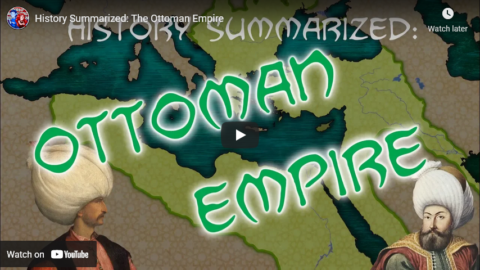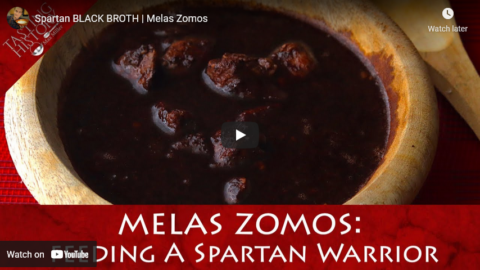Overly Sarcastic Productions
Published 5 Oct 2018Leave it to the furniture boys to pioneer a Comfort-First attitude towards Imperialism.
Join Blue in investigating the history of the Ottoman empire, and find out why “The Sick Man of Europe” is more than their nickname implies.
Further reading: Osman’s Dream by Caroline Finkel
Famous Turkish Song — Gunduz Gece: https://www.youtube.com/watch?v=2UcbH…
PATREON: www.patreon.com/OSP
MERCH LINKS:
Shirts – https://overlysarcasticproducts.threa…
All the other stuff – http://www.cafepress.com/OverlySarcas…Find us on Twitter @OSPYouTube!
January 5, 2022
History Summarized: The Ottoman Empire
John Ronald Reuel Tolkien
In The Critic, David Engels outlines the early life and career of J.R.R. Tolkien:
The biography of the British writer and philologist John Ronald Reuel Tolkien (1892-1973) is quickly summarised and, despite a few unusual cornerstones such as his early childhood in South Africa, the tragic death of his parents and the highly romantic love for his later wife Edith, not very spectacular. An existence confined entirely to the British Isles except for a few forays into the continent; a military service in the Great War only moderately traumatic compared to other fates; an honourable but hardly groundbreaking academic career; a life as father of a family that knew the most varied but hardly extraordinary fortunes.
Not really the stuff of legends — except for the global success of The Lord of the Rings, which arrived too late to set Tolkien’s existence on a different course. The (deeply unsatisfying) 2019 film adaptation of Tolkien’s youth attempts to surround him with the aura of a scholarly genius and war hero, and to explain his literary work biographically — but this reductionist attempt rather hinders the understanding of his oeuvre. Tolkien’s works are not exceptional because his life was: on the contrary, their exceptionality only gains its full significance when they are understood against the background of an altogether quite normal existence.
Of course, with such an undramatic approach, it is tempting to associate Tolkien’s enormous mythopoeic activity with the catchword “escapism”, and to reduce it once again to his biography, albeit this time not as a correspondence but as a compensation. This, too, misses the point — all the more so because Tolkien’s earliest literary activity goes far back into his teenage years: his work is not a reaction to his life, but rather the two grew in union, not unlike the mythical trees Telperion and Laurelin. Indeed, one might even regard Tolkien’s rather ordinary academic and family life as a consequence of his consuming, lifelong work on myth rather than the other way around. But what was Tolkien’s intention — and what can we learn from him?
In the beginning, there was disappointment. The Anglo-Saxon world, unlike France or Germany, has scarcely left any traces of an indigenous myth tradition; even the saga of King Arthur belongs to the pre-Anglo-Saxon, Celtic tradition. The Norman Conquest destroyed the entire Anglo-Saxon legend tradition, apart from a few nursery rhymes and place names and a very brittle literary corpus.
As an ardent lover of the Northwest of the Old World, the young Tolkien felt cut off from his own heritage and enthusiastically took up Indo-European linguistics as a technique for reconstructing the historical and mythical tradition of times long past. He set about, partly in play, partly in earnest, creatively deciphering and reconstructing the hitherto misunderstood evidence of England’s dark centuries. In the process, the boundary between etymology and mythopoetics quickly blurred, as Tolkien enriched the hypothetical material obtained by merging it with the archetypal content of the other legends of the ancient world. He created a mythical tradition that took on a character of its own.
But it would be wrong to interpret this legendarium, which was born out of linguistics but soon took on increasingly literary features, as a mere poetic game. Especially in the initial phase of his attempts, Tolkien endeavoured to introduce the increasingly coherent legends and sagas, which are known to the general public mainly through the posthumous Silmarillion and the publishing activities of his son Christopher, by use of a wide variety of framework plots, some of which have an old Anglo-Saxon character and some which are set in modern times. The leitmotif was the dream of the great wave that swallowed up a green island, which later became the seed of the “Fall of Númenor”; an image that haunted Tolkien himself often enough in his sleep and led him to state that those images, recorded partly in dreams and partly in a half-awake state, were not to be regarded as mere fiction, but rather as access to something true and permanent, which he fleshed out in various literary ways, but whose core consistently bore the character of a vision.
Spartan BLACK BROTH | Melas Zomos
Tasting History with Max Miller
Published 6 Oct 2020If you’ve ever wanted to be a Spartan warrior, then making a bowl of Melas Zomos is just a part of the process. Today, I cover each step in making both Melas Zomos and in making a Spartan warrior.
Follow Tasting History here:
Instagram: https://www.instagram.com/tastinghist…
Twitter: https://twitter.com/TastingHistory1
Reddit: r/TastingHistoryHelp Support the Channel with Patreon: https://www.patreon.com/tastinghistory
LINKS TO INGREDIENTS & EQUIPMENT**
Canon EOS M50 Camera: https://amzn.to/3amjvwu
Canon EF 50mm Lens: https://amzn.to/3iCrkB8
All-Clad Stock Pot: https://amzn.to/32HsYMx
Bay Leaves: https://amzn.to/33DnaTP
KitchenAid Blender: https://amzn.to/2RBkWi4LINKS TO SOURCES**
The Spartans by Paul Cartledge: https://amzn.to/35Jd2vo
Plutarch On Sparta: https://amzn.to/2H6SBhy
The Deipnosophistai by Athenaeus: https://amzn.to/3my5v8D
The Histories by Herodotus: https://amzn.to/32NdcQF
A Companion to Sparta by Anton Powell: https://amzn.to/3c94PSq
The Rise of the Greek Aristocratic Banquet by Marek Wecowski: https://amzn.to/2RFD5LK
Sparta Reconsidered by Helena P. Schrader: https://bit.ly/32FQOIM**Amazon offers a small commission on products sold through their affiliate links, so each purchase made from this link, whether this product or another, will help to support this channel with no additional cost to you.
MELAS ZOMOS
INGREDIENTS
– 2lb (1kg) Pig Leg (or other pork product)
– 2 Cups (1/2 liter) Pig Blood
– 1 Cup (235ml) White Wine Vinegar
– 2 Tablespoons Olive Oil
– 1 Tsp Salt
– 4 Cups (1 Litre) Water
– 3 Bay Leaf
– 1 Large Chopped OnionMETHOD
1. Set a large stock pot over medium heat, then add the olive oil and onions and cook until tender and lightly brown, about 10 minutes.
2. Add the chopped pork to the pot book for another 10 minutes.
3. Pour in the vinegar and 3-4 cups of water (4 if you have fresh pig’s blood, 3 if you have coagulated blood), the salt and the bay leaves. Once boiling, lower the heat to medium low and let the soup simmer, covered, for 45 minutes to and hour or until the pork is cooked through.
4. Add the pork blood* and simmer for 15 minutes more, then serve.
*If you are using coagulated pork blood, mix it with the final cup of water in a blender and blend until most of it is liquid. Strain out any large chunks and add the liquid to the soup.PHOTO CREDITS
Symposium Scene: Marie-Lan Nguyen / https://bit.ly/3muYyoI
Schwarzsauer: Overbergderivative work / https://bit.ly/2ZJxBUq
Dinuguan with puto: Lambanog / https://bit.ly/3mrLyAg
Odaker: https://bit.ly/2ZKFRUi
Plutarch Bust: Odyssey / https://bit.ly/2FAYO54
Roman mosaic from Dougga: Pascal Radigue / https://bit.ly/2E6Wu4Y
Greek Vase with Child: National Archaeological Museum of Athens / https://bit.ly/2H04tlo
Sarcophagus Marcus Cornelius Statius: Louvre Museum / https://bit.ly/2ZK3bla
Dionysus with Hermes on Jug: MatthiasKabel – https://bit.ly/2FECCqL
Mt Taygetus: Gepsimos – https://bit.ly/32A4SU8
Eurotas River: Gepsimos / https://bit.ly/2Fv4AVY
Xerxes: Darafsh / https://bit.ly/2H0lWds
QotD: Measurement hack that lives on
The geeks at the Massachusetts Institute of Technology are fond of merry japes, locally known as “hacks”. One of the more memorable happened one night in October 1958 when an MIT fraternity had the idea of initiating new members by making them measure a bridge over the Charles River connecting the Cambridge campus with Boston. Crossing the bridge was often a wet, windy and unpleasant business and it was thought that students returning at night from downtown would like to know, by visible marks and with some precision, how far they still had to go. The older fraternity brothers decided to use one of the new pledges as a rule, and selected Oliver R. Smoot, the shortest of the lot at 5ft 7in. The other pledges laid Smoot out at one end of the bridge, marked his extent with chalk and paint, then picked him up and laid him down again, spelling out the full measurement every ten lengths, and inscribing the mid-point of the bridge with the words “halfway to Hell”. In this way, it was determined that the span was 364.4 smoots long, “plus or minus one ear” (to indicate measurement uncertainty).
The hack was too good to let fade away, so every now and then the fraternity makes its pledges repaint the markings. You might think this isn’t the sort of vandalism the police would tolerate, but they do. The smoot markings soon became convenient in recording the exact location of traffic accidents, so (as the story goes) when the bridge walkways needed to be repaved in 1987, the Massachusetts Department of Public Works directed the construction company to lay out the concrete slabs on the walkway not in the customary six-foot lengths but in shorter smoot units. Fifty years after the original hack, the smoot markers have become part of civic tradition: the City of Cambridge declared 4 October 2008 “Smoot Day”. MIT students ran up a commemorative plaque on a precision milling machine and created an aluminium Smoot Stick which they deposited in the university’s museum as a durable reference standard: the unit-smoot is now detached from the person-Smoot. Through the legions of MIT graduates driving global high-tech culture, the smoot has travelled the world. If you use Google Earth, you can elect the units of length in which you’d like distances measured: miles, kilometres, yards, feet – and smoots.
Robert Crease, The Historic Quest for an Absolute System of Measurement, 2011.






